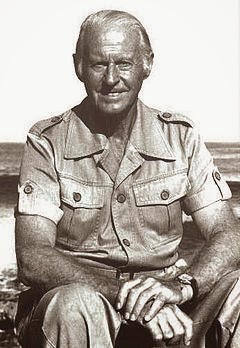Thor Heyerdahl was a Norwegian ethnographer and adventurer with a background in zoology, botany, and geography. He became notable for his Kon-Tiki expedition in 1947, in which he sailed 8,000 km (5,000 mi) across the Pacific Ocean in a hand-built raft from South America to the Tuamotu Islands. The expedition was designed to demonstrate that ancient people could have made long sea voyages, creating contacts between separate cultures. This was linked to a diffusionist model of cultural development. Heyerdahl subsequently made other voyages designed to demonstrate the possibility of contact between widely separated ancient people. He was appointed a government scholar in 1984.
Thor Heyerdahl become a trend in Denmark since Google Doodle Celebrate his 100th Birthday. Google has used its latest animated home page
doodle to celebrate the life of Norwegian ethnographer explorer Thor
Heyerdahl, best known for leading the Kon-Tiki expedition of 1947, who
was born on this day in 1914.
In the expedition, Heyerdahl and his crew of five sailed a balsa wood
raft 5,000 miles westwards from Peru towards French Polynesia in an
attempt to prove his hypothesis that the islands were colonised from the
Americas, rather than from the Asian mainland, as had previously been
thought.
The point of the journey was to travel on a raft built
using materials and technology that would have been available to
pre-Colombian Americans, i.e. those living on the continent before the
arrival of Europeans, headed by Christopher Columbus, in 1492.
People
found it hard to believe that such distances could be covered using
such basic vessels. The journey was successful, with the Kon-Tiki making
landfall in the Tuamoto Islands on 7 August 1947, 101 days after
setting sail.
The doodle also shows a moai, one of the huge sculptures
found on Rapa Nui, or Easter Island, which Heyerdahl visited from 1955-6
on an archaeological expedition. Again, he was keen to prove that the
island had been settled from the east rather than the west. Heyerdahl's
theories have largely not been backed up by DNA testing.
Heyerdahl
was born in Larvik in southern Norway and studied zoology and geography
at the University of Oslo, while studying Polynesian culture in his
spare time. He fought during the Second World War with the Free
Norwegian Forces, following the Nazi occupation of the country. He
married three times, and died in 2002.
Heyerdahl's expeditions
made him one of the most famous anthropologists in the world, writing a
number of books that became huge-sellers, and making a 1951 documentary
film about the Kon-Tiki expedition, which went on win an Academy Award.
The story was adapted again into a feature film in Norway in 2012, which
was both the country's most expensive and highest-grossing movie.

No comments:
Post a Comment